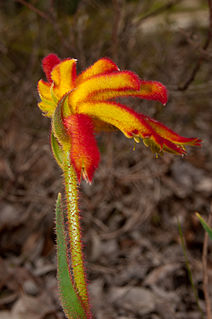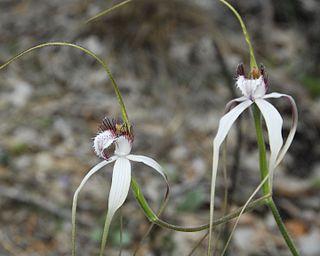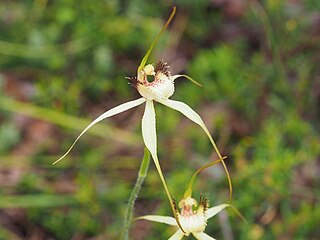
Anigozanthos is a small genus of Australian plants in the bloodwort family Haemodoraceae. The 11 species and several subspecies are commonly known as kangaroo paw and catspaw depending on the shape of their flowers. A further species, previously identified as Anigozanthos fuliginosus and commonly known as the black kangaroo paw, has been transferred to its own monotypic genus and is now known as Macropidia fuliginosa.

Kangaroo paw is the common name for a number of species, in two genera of the family Haemodoraceae, that are endemic to the south-west of Western Australia. These rhizomatous perennial plants are noted for their unique bird-attracting flowers. The tubular flowers are coated with dense hairs and open at the apex with six claw-like structures, and it is from this paw-like formation that the common name "kangaroo paw" is derived.

Banksia chamaephyton, commonly known as the fishbone banksia, is a species of shrub that is endemic to Western Australia. It has prostrate, underground stems, pinnatipartite leaves, cream-coloured and brown flowers arranged in spikes surrounded by hairy bracts. It grows in kwongan near the lower west coast.

Anigozanthos manglesii, commonly known as the red-and-green kangaroo paw, Mangles kangaroo paw, Kurulbrang (Noongar), is a plant species endemic to Western Australia, and the floral emblem of that state.

Eucalyptus rudis, commonly known as flooded gum or moitch, is a species of small to medium-sized tree endemic to coastal areas near Perth, Western Australia. The Noongar names for the tree are colaille, gooloorto, koolert and moitch. This tree has rough, fibrous bark on the trunk and large branches, smooth greyish bark above, lance-shaped to curved adult leaves, flower buds in groups of between seven and eleven, white flowers and bell-shaped, cup-shaped or hemispherical fruit.

Melaleuca huegelii, commonly known as chenille honey-myrtle, is a plant in the myrtle family, Myrtaceae and is endemic to the south-west coastal areas of Western Australia. It has small, almost scale-like leaves and flower spikes sometimes more than 100 millimetres (4 in) long on the ends many of its branches.

Caladenia flava, commonly known as cowslip orchid, is a species of orchid endemic to the south-west of Western Australia. It is a relatively common orchid with a single, hairy leaf and up to three yellow flowers which often have red markings. In 2001 three subspecies were named and a fourth is recognised but not as yet formally described.

Anigozanthos humilis is a species of Anigozanthos in the family Haemodoraceae. This flowering perennial plant is endemic to Southwest Australia and widespread in its open forests. Common names include Catspaw and Common Cat's Paw.

Anigozanthos flavidus is a species of plant found in Southwest Australia. It is member of the Haemodoraceae family. It is commonly known as the tall, yellow, or evergreen, kangaroo paw. The specific epithet, flavidus, refers to the yellow flowers of this plant.

Caladenia longicauda is a species of plant in the orchid family Orchidaceae and is endemic to the south-west of Western Australia. It is distinguished by its large leaf and by its up to five large, white flowers which have drooping sepals and petals with long, thickish brown "tails".

Conostylis aculeata, commonly known as prickly conostylis, is a tufted perennial plant species in the family Haemodoraceae. It is endemic to the south-west of Western Australia. Plants grow to between 5 and 60 cm high and produce yellow flowers between August and November in the species' native range.

Eucalyptus arachnaea, commonly known as the black-stemmed mallee, is a mallee or tree that is endemic to Western Australia. It has rough, stringy bark, lance-shaped leaves and white flowers in groups of up to thirteen.

Caladenia busselliana, commonly known as Bussell's spider orchid, is a plant in the orchid family Orchidaceae and is endemic to a small area in the south-west of Western Australia. It is a rare orchid with an erect, hairy leaf and up to three pale yellow flowers. Only about fifty specimens are known and it is threatened by habitat destruction and by too-frequent or too infrequent bushfires.

Caladenia caesarea subsp. maritima, commonly known as the cape spider orchid, is a plant in the orchid family Orchidaceae and is endemic to the south-west of Western Australia. It has a single spreading, hairy leaf and up to three small mustard-coloured flowers with red stripes. It is only known from a small coastal area near Cape Leeuwin where it grows in clumps of ten or more.
Caladenia graniticola, commonly known as the Pingaring spider orchid, is a species of orchid endemic to the south-west of Western Australia. It has a single, hairy leaf and one or two yellowish-green, red and white flowers which have a greenish-yellow and white labellum with a red tip. It was originally described as Caladenia hoffmanii subsp. graniticola but has a slightly different labellum and column.

Caladenia longicauda subsp. rigidula, commonly known as the rigid white spider orchid or island white spider orchid, is a plant in the orchid family Orchidaceae and is endemic to the south-west of Western Australia. It has a single hairy leaf and up to three large, mainly white flowers with relatively short lateral sepals and petals. It is similar to the reclining white spider orchid but that species has smaller, cream-coloured flowers.
Caladenia remota subsp. remota, commonly known as the outback spider orchid, is a plant in the orchid family Orchidaceae and is endemic to the south-west of Western Australia. It has a single hairy leaf and one or two relatively large creamy-white to pale yellow flowers. It is relatively common in moist soil around granite outcrops, growing in more inland areas than most other spider orchids.

Caladenia remota subsp. parva, commonly known as the Perenjori spider orchid, is a plant in the orchid family Orchidaceae and is endemic to the south-west of Western Australia. It has a single hairy leaf and up to three creamy-white to pale yellow flowers. It has a more restricted and more westerly distribution than subspecies remota.

Anigozanthos rufus is a grass-like evergreen perennial plant native to the southern coasts of Western Australia. Common names include red kangaroo paw, crimson kangaroo paw, and backdraft.

Anigozanthos viridis, commonly known as Green Kangaroo Paw, is a grass-like perennial herb native to the south western coastal parts of Western Australia. The Noongar peoples know the plant as Koroylbardany.



















